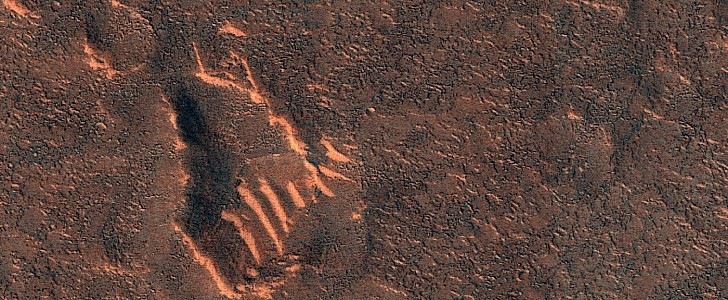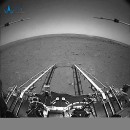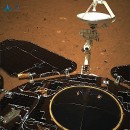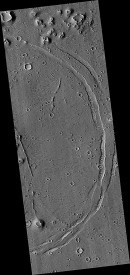It’s no secret anymore that if we somehow manage to avoid a devastating conflict here on our home planet, we humans are going to visit Mars and, who knows, maybe even make of the place a second home for ourselves.
At the time of writing, no official crewed mission is planned for Mars. In fact, humans are presently very busy trying to make a comeback to visiting the Moon, with the Artemis I test mission possibly less than a month away.
Technically, NASA never said it is definitely going to send humans to Mars. But somehow we stumbled across the main image of this pic, and we got our hopes up as soon as we laid our eyes on it.
The photo was taken by the HiRISE camera from an altitude of 290 km (180 miles) less than two years ago. It shows a portion of the Utopia region, the largest impact basin our species knows of in this solar system, measuring some 3,300 km (2,050 miles) in diameter.
Sporting several small craters and a feature that to these eyes looks like the footprint of some Martian Yeti, the place could make for a perfect landing spot for future missions to the planet, not only robotic, says NASA, but also human.
The space agency is using such high-resolution images to pick the best landing spots on the Red Planet, saying HiRISE is “an excellent instrument to study the terrain.”
This particular location could be considered as part of a larger list of landing spots, as it may be “a good place to land a vehicle for future exploration of potential mud volcano areas and also to assess surface roughness.”
It’s unlikely though humans will be sent there anytime soon. Contrary to the most optimistic estimates, which claim a human Mars landing could happen by 2030, it will most likely take several more decades until that actually comes to pass.
Until then, we’re only left with drooling over the tens of thousands of images sent back by the HiRISE, showing the place in the sky we humans dream the most of visiting.
Technically, NASA never said it is definitely going to send humans to Mars. But somehow we stumbled across the main image of this pic, and we got our hopes up as soon as we laid our eyes on it.
The photo was taken by the HiRISE camera from an altitude of 290 km (180 miles) less than two years ago. It shows a portion of the Utopia region, the largest impact basin our species knows of in this solar system, measuring some 3,300 km (2,050 miles) in diameter.
Sporting several small craters and a feature that to these eyes looks like the footprint of some Martian Yeti, the place could make for a perfect landing spot for future missions to the planet, not only robotic, says NASA, but also human.
The space agency is using such high-resolution images to pick the best landing spots on the Red Planet, saying HiRISE is “an excellent instrument to study the terrain.”
This particular location could be considered as part of a larger list of landing spots, as it may be “a good place to land a vehicle for future exploration of potential mud volcano areas and also to assess surface roughness.”
It’s unlikely though humans will be sent there anytime soon. Contrary to the most optimistic estimates, which claim a human Mars landing could happen by 2030, it will most likely take several more decades until that actually comes to pass.
Until then, we’re only left with drooling over the tens of thousands of images sent back by the HiRISE, showing the place in the sky we humans dream the most of visiting.








